
Features
Aggregates
Profiles
Fighting the Flood
BURNCO navigates the devastation caused by Alberta flooding.
December 2, 2013 By Andrew Macklin
The summer of 2013 was difficult for businesses and homeowners living in southern Alberta.
The summer of 2013 was difficult for businesses and homeowners living in southern Alberta. From June 20 to 23, record-setting precipitation in central and southern Alberta caused severe flooding that displaced tens of thousands of residents and led to 27 states of local emergency.
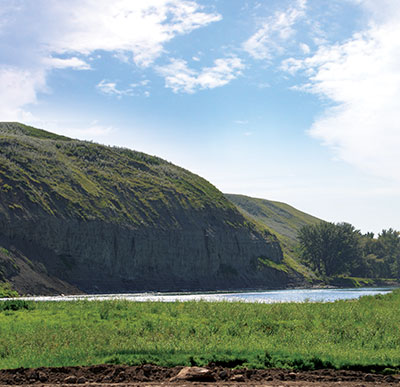
|
|
The flood also halted the regular day-to-day operations of the business community. Business was no longer as usual, and the days and weeks to follow would focus on clean-up efforts rather than usual business routines. There was the matter of figuring out what would be funded through existing insurance policies. Operators needed to take care of co-workers affected by the flooding and repair any damages to the physical
infrastructure.
That was the case for BURNCO, one of Alberta’s largest gravel suppliers. BURNCO currently has over 20 pits in the province, along with a few in B.C. and Saskatchewan, and several of them are in the part of southern Alberta that was impacted by the flooding.
On the morning of June 21, the city of Calgary was under a state of local emergency as the Bow River was expected to crest later that day. At the southeast corner of Calgary lies BURNCO’s flagship pit, Indus, which produces more than one million tonnes of aggregate per year. The Bow River, which runs through Calgary from northwest to southeast, runs right along the southern edge of the Indus property.
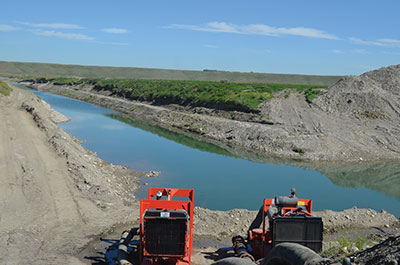 |
|
| A system of pumps was brought in to help drain the estimated two billion gallons of water that flooded the main pit at Indus.
|
“Much of the gravel (at Indus) is above the natural water table but significant portions of it are below,” says Alan Paul, regional manager, southern Alberta aggregate. “We had dewatering channels and ponds in place to mine all of the gravel out and had the areas bermed off along the river as we were mining.”
When the Bow River began to rise on June 21, and neighbourhoods in the surrounding low-lying areas began to flood, officials at BURNCO began to recognize the damage that could be done and worked quickly to move the company’s equipment inventory in the low-lying areas on the site. Wheeled and tracked equipment was moved to higher ground before the highest river levels reached the section of the Bow River south
of the pit.
Later in the day on June 21, the Bow River shot over top of the berms and rushed through the property, carving a path to the low-lying areas throughout Indus. The normal flow of the Bow River is around 100 cubic metres per second, but at the time it came into the Indus, the flow was estimated at 1,800 cubic metres per second. Company officials believed that, at the time of the flooding, 20 per cent of the Bow River was flowing through the Indus property.
“Once the river came in, it went back out at the bottom end of the pit,” Paul says. “So once the river receded, it could only recede to the level of the Bow River at the lower end, which still left, in some areas, 15-20 metres of depth of water.”
Because the company had acted once the impact of the flooding had been seen in Calgary, BURNCO was able to minimize their own property loss at Indus.
“In terms of physical asset loss, it was minimal,” says Paul. “It was small stuff like pumps that we lost. But our sub-contractor still had two long-reach hoes, a grader and two rock trucks sitting in the flooded pit.”
Dealing with the damage
BURNCO was quick to assess the damage to Indus and begin making the necessary adjustments to its gravel operation. Because of the location of the gravel stockpiles at the Indus site, inaccessible because of the flooding, the team had to come up with a plan to ensure that clean gravel was still available.
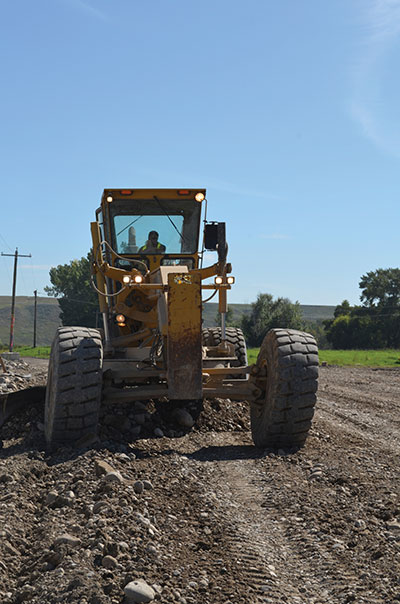 |
|
| A grader works to rebuild the berm at the south end of the Indus pit.
|
“We found alternate areas in the pit where we were able to access raw pit run that we could feed back in to the crusher and wash plant,” Paul explains.
It was difficult to assess, in the first few days following the flooding, just how high the demand would be for gravel. Roads were broken, bridges were washed away, and the banks of the river system would need to be restored. At the same time, many communities were still not functioning very well and had not yet started to make many of the necessary repairs.
“There was a lull in demand immediately after the flood, for about the first week or so,” explains Mike Powell, president of BURNCO. “A lot of the work that was scheduled simply didn’t happen for a while. That helped us a bit. We moved manpower around. We moved guys to other pits. We stepped up production in some places.”
With aggregate production now focused elsewhere, cleanup of the Indus site could begin. The main pit remained flooded, with several pieces of equipment completely submerged. In order to begin the process of draining the pit, dewatering channels, berms and ponds had to be reconstructed. That process took six to eight weeks, allowing BURNCO to finally begin draining the pit in mid-August.
There were still major challenges to overcome in draining the pit. First, the volume of the water was massive. BURNCO estimates that the main pit had been filled with close to two billion gallons of water. Draining the pit would have to involve pumping and filtering the water, meeting the mandate of the Ministry of the Environment for the maximum amount they could return to the river each day. Also, they would have to ensure that the quality of water leaving the pit is the same or better than the quality of water flowing through the river. In total, the draining operation would take approximately eight weeks to complete.
Impacting the bottom line
With so many changes to the company’s operation in a short amount of time, the shift in production and resources had a significant impact on the company’s bottom line.
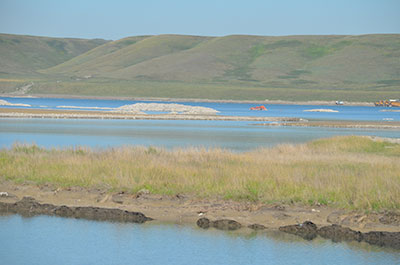
|
|
| Looking across the main pit two months after the flood, one can see the top of an excavator belonging to Contour Earthmoving Ltd. breaching the top of the water.
|
In addition to bearing the full impact of the flooding at Indus, BURNCO’s retail operation suffered significant losses as the property flooded and aggregate resources were contaminated. Anything that didn’t wash away with the draining water was covered in silt, no longer a marketable product.
“We do have some significant uninsured losses in terms of physical property,” explains Powell. “We’ve got losses in business interruption, and those are pretty significant too.”
Powell suggests that the overall financial loss for the company will be “in the millions,” with the cost of business interruption ultimately being greater than the cost of the lost physical assets. It wasn’t until two months after the flood that business was finally getting back to normal, with an expectation that there would be additional work coming for infrastructure repair.
“There is going to be a huge amount of repair business to be done,” says Powell. “We are going to see an uptick in business at some point. Likely not until next year, depending on how much they are able to get done this year.”
In the meantime, the rebuilding process underway at BURNCO will not be to the same standards or specifications that were previously in place. The flood has caused the company to rethink elements of the operations and be prepared in the event that it happens again. That involves taking a look at the location of stockpiles, scales, equipment storage and the buildings. In the rebuild, these assets will be moved to higher ground wherever possible, above the water table to prevent from potential flood damage.
The location of the company’s physical assets is not the only factor to take into consideration according to Paul. “It’s not just the crusher and the wash plant and what you’ve produced; it’s what you’ve done with the dirt in the stripping and reclamation process. It’s huge money. What have you done with it and what happens if you have a catastrophe that takes it away?”
Reclamation materials are not something that is normally recognized as an asset. However, in the situation being faced by BURNCO at the Indus location, reclamation materials are an asset that will be costly to replace as a result of the acquisition, distribution and labour needed at the site.
Lessons learned
Planning for a natural disaster is difficult to do without a full appreciation of assets and the potential damage that can be done. But not knowing how to react or what potential signals there may be to alert you to a pending disaster are just as detrimental to the overall impact such an event can have on a business.
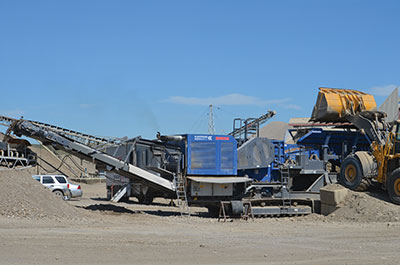
|
|
| BURNCO had to shift its gravel production at Indus to the other side of the pit in order to continue to meet demands for crushed stone.
|
“We were all aware that the river was coming up and we probably took that a little more lightly than we should have,” says Powell. “We probably should have taken more measures.”
That’s difficult to do when you don’t have any appreciation for the warning signs that a disaster is imminent. In the case of the Alberta flooding, there didn’t seem to be an appreciation of the severity of the water flow until it was too late.
“The concept of metres per second of flow in the river was something that wasn’t talked about on flooding event day, but it has been talked about a great deal since then,” says Powell. “We needed to have a better understanding of what that meant.”
But according to Powell, the loss of physical and financial assets by BURNCO, however significant, means little compared to what happened to people throughout the surrounding communities. Thirteen of BURNCO’s employees were displaced from their homes, and many more had friends and family impacted by the flood.
“What we went through really pales in comparison to what all of the homeowners went through in places like High River and Bragg Creek. These people were absolutely devastated; we had a setback. As the government takes measures to protect homes and people and personal assets, these will look after our needs as well.”
Hopefully, the flooding in southern Alberta was a fluke, something that the province never has to endure again. But in case a perfect storm hits southern Alberta again, BURNCO has learned what it will need to do in order to be prepared for it.
Print this page